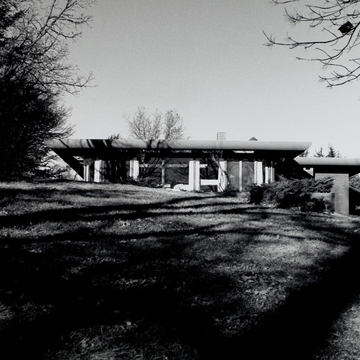You are here
Walter House (Cedar Rock)
Situated close to the small community of Quasqueton is Cedar Rock, the Lowell Walter house designed by Frank Lloyd Wright. The complex consists of the house itself (1945–1950) and the guesthouse/boathouse (1945–1948) located on the east shore of the Wapsipinicon River. As with a number of Wright's post-World War II houses, the scheme of the Walter house is based on his late 1930s Usonian house: there is a central module—containing the living, dining, and kitchen corner—and then a long corridored wing containing, as in a railroad car, a line of bedrooms. Entrance to the house is off the carport and auto court, via a long sheltered walkway parallel to the bedroom gallery. The central module of the Walter house is the square garden room with walls of glass that provide a view of the river below. The other walls of the house are of red brick; the roof, a thin slab of concrete, was planned to be covered in black earth and peat moss. Almost all of the furniture was designed by Wright. The house is now owned by the Iowa Conservation Commission and is open to the public.
Writing Credits
If SAH Archipedia has been useful to you, please consider supporting it.
SAH Archipedia tells the story of the United States through its buildings, landscapes, and cities. This freely available resource empowers the public with authoritative knowledge that deepens their understanding and appreciation of the built environment. But the Society of Architectural Historians, which created SAH Archipedia with University of Virginia Press, needs your support to maintain the high-caliber research, writing, photography, cartography, editing, design, and programming that make SAH Archipedia a trusted online resource available to all who value the history of place, heritage tourism, and learning.

















